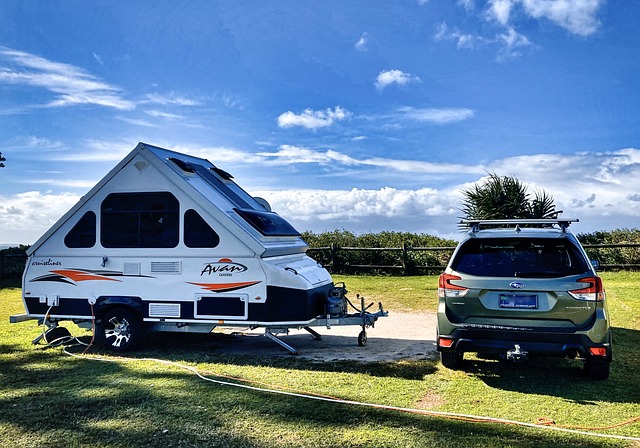When planning a road trip with a caravan in windy conditions, match your vehicle's towing capacity to the caravan's recommended weight and choose models designed for stability and aerodynamics. Prioritize safety by securing connections, inspecting seals, driving at safe speeds, and using proper coupling mechanisms. Opt for lightweight caravans with low centers of gravity and consider wind stabilizers or protection kits for enhanced control in high winds. Ensure compatibility between your vehicle and caravan through specifications and owner manuals to guarantee a secure journey.
Towing a caravan in windy conditions requires careful preparation and knowledge. Understanding the dynamics of caravan towing in such weather is crucial for safety. Not sure what caravan you can tow? Choosing the right vehicle with sufficient towing capacity is essential. This guide covers everything from selecting the best caravans for towing to implementing vital safety measures. Learn tips for maintaining control and stability, ensuring a secure journey even in challenging wind conditions.
- Understanding Caravan Towing Dynamics in Windy Weather
- Choosing the Right Caravan for Secure Towing
- Essential Safety Measures When Towing in Wind
- Tips for Maintaining Control and Stability While Towing a Caravan in Windy Conditions
Understanding Caravan Towing Dynamics in Windy Weather
When planning a road trip with a caravan in windy conditions, understanding how wind dynamics affect your towing setup is crucial. The interaction between the trailer and the towing vehicle becomes more complex when facing strong winds. Factors like the caravan’s size, shape, and weight distribution play significant roles in its stability. For instance, longer and wider caravans tend to be more affected by sidewinds, requiring a higher towing capacity from your vehicle to maintain control.
Choosing the right caravan for your needs is essential. Opting for a model designed with aerodynamics in mind can make towing easier, especially during windy seasons. The best caravans for towing often feature streamlined shapes, well-balanced weight distribution, and sturdy construction to enhance stability. Always consider your vehicle’s towing capacity specifications and match them with the caravan’s recommended weight rating to ensure safe and secure transportation without compromising control on winding roads or open highways.
Choosing the Right Caravan for Secure Towing
When considering how to tow a caravan in windy conditions, the first step is ensuring your vehicle and trailer are a suitable match. Choosing the right caravan for secure towing is paramount. Look for models designed with stability and wind resistance in mind. The best caravans for towing often feature aerodynamic shapes, wide bases, and robust construction to withstand strong winds.
Caravan towing capacity varies widely between models and manufacturers, so it’s crucial to match your vehicle’s towing capabilities to the caravan’s weight and size. Check the vehicle’s owner manual for its towing limits and ensure the caravan’s gross vehicle weight rating (GVWR) is within these parameters. This combination will guarantee a safe and secure towing experience, even in challenging weather conditions like high winds.
Essential Safety Measures When Towing in Wind
When towing a caravan in windy conditions, safety should always be your top priority. Before hitting the road, ensure your vehicle is equipped with proper towing accessories and that your caravan is securely attached using appropriate coupling mechanisms. Check the recommended towing capacity of your vehicle to confirm it can handle the weight of the loaded caravan; this information is typically found in your vehicle’s manual or on its specifications plate.
Additionally, choose a suitable caravan for towing based on its design and construction, focusing on models known for their stability and wind resistance. Lightweight caravans with a lower center of gravity tend to be better suited for navigating high winds. Regularly inspect the caravan’s connections and ensure all doors, windows, and vents are sealed tightly to minimize drag and reduce the risk of detachment. Always drive at safe speeds during windy conditions, keeping a firm grip on the steering wheel and being prepared to adjust your course as needed.
Tips for Maintaining Control and Stability While Towing a Caravan in Windy Conditions
When navigating windy conditions with a caravan, maintaining control and stability is paramount. Firstly, ensure your vehicle has the suitable towing capacity to handle the weight of the caravan. Check both your vehicle’s owner manual and the caravan’s specifications to confirm it’s a safe combination. Best caravans for towing are those designed with aerodynamic features and stable bases, which can enhance control during high winds.
Second, secure the caravan properly using appropriate hitching techniques and equipment. Use wind stabilizers or side-wind protection kits recommended by manufacturers. Adjust mirrors for better visibility, and drive at a speed that allows you to react swiftly to unexpected gusts. Regularly monitor road conditions and be prepared to slow down or seek shelter in strong winds. Remember, what caravan can I tow safely depends on various factors, including the vehicle’s towing capacity and the specific features of the caravan itself.
Towing a caravan in windy conditions requires careful preparation and knowledge of the right techniques. By understanding the dynamics of caravan towing, selecting the best caravans for towing based on your vehicle’s capacity, and implementing essential safety measures, you can ensure a secure and controlled journey. Always remember that proper control and stability are key to navigating challenging weather conditions, so be sure to practice and stay safe on the road. Choose a reliable caravan with features designed to enhance stability, and consult your vehicle’s owner manual for specific towing capacity guidelines.
